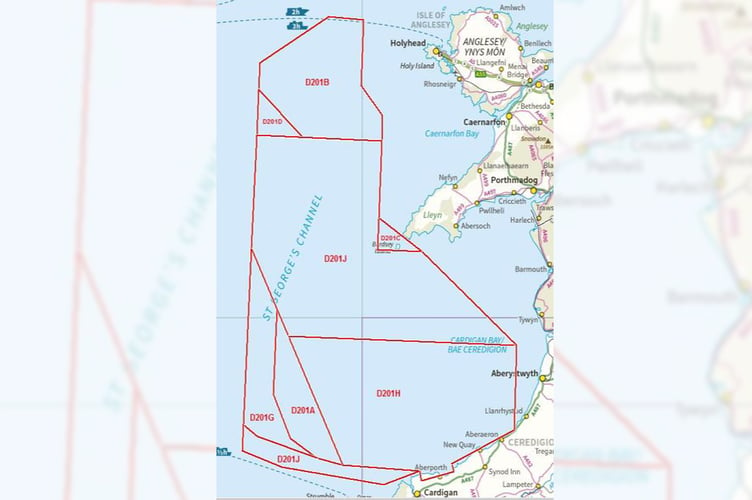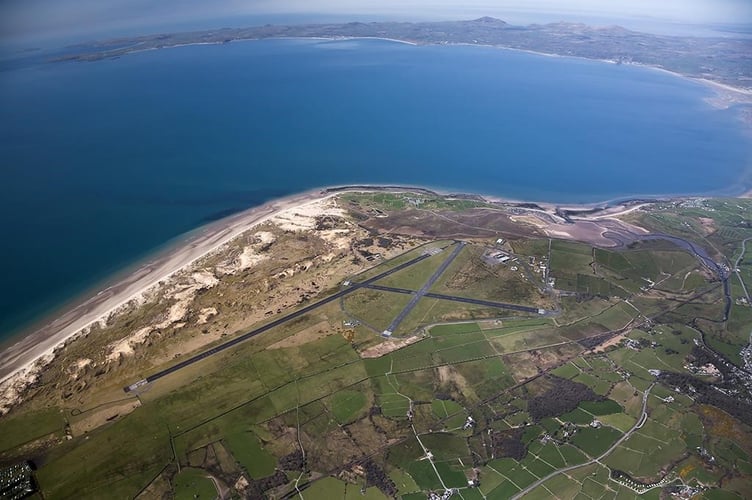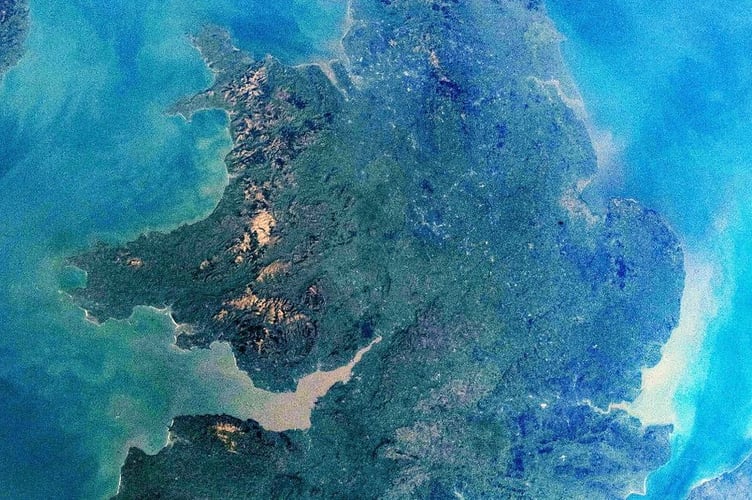Cardigan Bay is set to play a pivotal role in the burgeoning 21st century space race.
In the last week it has been announced that Cawdor Barracks near St Davids in Pembrokeshire is the preferred location for a new deep space radar system that will protect the UK from “space warfare” and ‘detect objects in deep space’.
The Snowdonia Space Centre, situated at the former Llanbedr Airfield has also secured £820,000 of funding from the UK Space Agency.
The centre will develop the Space Technology Test Centre (STTC), in partnership with Newton Launch Systems Ltd.
The centre will exploit the unique location of the Snowdonia Space Centre, with its own immediate Danger Area and direct access to a larger Danger Area over Cardigan Bay, to provide a flight test range for rocket-powered test vehicles, near-space scientific flights, microgravity research and trials of re-entry vehicles and payload recovery systems.

The Cardigan Bay danger area was established during the Second World War and covers 6,500 square kilometres of Cardigan Bay from sea level to unlimited height, stretching from Aberporth in the south to the sea west of Anglesey.
The danger zone is described as being ideally suited for spaceplane operations.
The test range will be complemented by a space technology testing laboratory in Llanbedr, featuring a centrifuge, thermal vacuum chamber, vibration table, aerostructures rig and a rocket engine test stand.
In support of these activities, the grant together with private investment will be used to develop new Research, Development, Test and Evaluation (RDT&E) infrastructure including the installation of two launch rails and the necessary tracking and communications equipment to enable safe operation of the range.
The flight test range will be complemented by a space technology testing laboratory and rocket propulsion test facility.
The grant and private investment will fund the refurbishment of an existing building to laboratory standards, the installation of a clean room in another existing building, an upgrade to an existing thermal vacuum test facility, new centrifuge and a 5 kN sea-level rocket test stand with fixed infrastructure designed to accommodate up to 50 kN thrust to allow for future development. The proposed STTC will be made available to UK organisations to develop, test and qualify space technology and products in advance of commercial exploitation and to host training events supporting the UK skills base.
The project is expected to be completed by March 2025.

Snowdonia Aerospace Centre, who currently operate the former Llanbedr Airfield, has already invested over £2m in the refurbishment of the Llanbedr infrastructure across the site to create a multi-use flight test centre for new and novel aerospace and space systems, including creation of a permanent Danger Area to support experimental flight testing over Cardigan Bay along with the necessary supporting Air Navigation Service Provision (ANSP).
In addition, Newton Launch Systems Ltd has invested in office and laboratory facilities at the Snowdonia Space Centre to support small scale rocket testing. This proposal will support expansion of these facilities and the creation of a dedicated Space Technology Test Centre that can be offered as an on-demand service to the UK space community.
Lee Paul of the Space Centre said: “The SCIF grant will enable the Snowdonia Space Centre to accelerate the development of its proposed space technology test facility and act as a catalyst for further future private investment within this sector.
“The multi-use complex will be made available to SMEs, start-ups and academia at relatively short notice. The entire facility will be made available as an education and training venue for students and graduates from across the UK, thereby helping to fill the skills shortage currently affecting the space sector in the UK.
“The proposed new space testing facilities will be made readily available to academic institutions to support their technology and engineering education programs. There is also a specific intention by the project consortium to use these facilities part-time to directly support STEM training and skills education in space environment testing and space technology testing, offering hands-on experience and training to upcoming and recent graduates to help burnish their skills in the space sector.
“We understand that there are very few academic institutions who are able to offer this sort of hands-on training, and there is a noted gap in practical skills for new graduates in the UK space sector.
“Employers currently have to provide their own in-house training, which is only economical for the largest firms in the sector.
“By offering such training opportunities, the project aims to support up-skilling of the UK space industry to support the UK’s ambitious growth targets.”
Deep Space Advanced Radar Capability

The UK Government has confirmed that Cawdor Barracks is its preferred site for a deep space radar, which, along with two other sites in Australia and the USA, will increase UK security by being able to better detect, track and identify objects in deep space.
The Deep Space Advanced Radar Capability (DARC) programme – unveiled by the respective Defence Secretaries of Australia, the United Kingdom and the United States - will provide 24/7, all-weather capabilities that will increase AUKUS nations’ ability to characterise objects deep in space up to 22,000 miles (36,000 kilometres) away from earth.
DARC will see a global network of three ground-based radars to be jointly operated that will assist in critical space-traffic management and contribute to the global surveillance of satellites in deep space.
The unique geographic positioning of AUKUS nations means that DARC can provide global coverage, including detecting potential threats to defence or civilian space systems.
As the danger of space warfare increases, this landmark capability will benefit all three nations’ land, air, and maritime forces, as well as protecting critical infrastructure and benefitting our domestic construction and space industries.
These new radar systems have higher sensitivity, better accuracy, increased capacity, and more agile tracking than current radars and optical systems tracking objects in deep space orbit.
This will see greater global monitoring provided to inform UK defence operations, bypassing the current inclement weather and daylight limitations of some current capabilities.
The first DARC radar site which, is being constructed in Australia, is expected to be operational in 2026, with all three sites operational by the end of the decade.
Jeremy Howitt further added: “Flight testing facilities for rocket powered vehicles are uncommon globally, so we are anticipating interest from overseas customers.
“Providing integrated ground and flight test facilities at the Snowdonia Space Centre will significantly reduce the costs for low-TRL development of novel next-generation concepts including spaceplanes, reusable satellites with re-entry and recovery systems, tests of vehicle Flight Termination Systems and launch vehicle recovery systems.
“The combination of test range and laboratory will enable systems to be tested in ways that pure aerospace facilities and traditional space environment ground testing facilities cannot accommodate. Offering these facilities at a significantly lower price than the competition (made possible by the multi-use nature of the complex and the ability to share running costs across sectors) is expected to attract significant interest and expand the UK space sector.”
Dr Rosie Cane, cluster development manager for Space Wales said “The development of a new Space Technology Centre at Snowdonia Space Centre marks a significant milestone in the Wales Space Cluster, which will deliver substantial benefits to SMEs, academia, and the wider UK space ecosystem.”
The STTC will sit as part of a potential space-related business portfolio that now spans the spectrum from entertainment and education (dark skies observatory and planetarium), science and learning (radio telescope for deep space imaging), satellite and space debris tracking (radio telescope as a bi-static radar), through to ground-based development and near-space flight testing of launch technology and in-orbit hardware.
Sustainable space
These schemes compliment a Welsh Government Strategy to make Wales a ‘sustainable space nation’.
The Wales Space Strategy is focused on growing the potential of current and future developments in the space sector in Wales, including:
• Space launch, training and experience capability at Spaceport Snowdonia at Llanbedr in Gwynedd, and proposals for sea-based launch platform to operate from Port Talbot;
• Strengths in areas such as low earth observation satellite capabilities, including Cardiff-based Space Forge which is developing a reusable manufacturing space satellite. The company plans the launch of its first made-in-Wales satellite in 2023, return by 2024 and relaunch by 2025.
• Satellite technology used to find water on other planets is being trialled in Wales as part of potential opportunities to make Wales’ coal tips safer.
• Test and evaluation of new greener propulsion technologies at existing facilities, including Llanbedr, Aberporth Range in Ceredigion, Radnor Range in Powys and Pendine in Carmarthenshire;
• A cluster of pioneering companies including Airbus Defence & Space, Raytheon, Qinetiq, and Qioptiq - who manufacture 98 per cent of the global supply of space-qualified glass used in satellites and space vehicles;
• A network of research and teaching facilities, including the Compound Semiconductor Applications Catapult in Newport and AMRC Cymru in Broughton, Flintshire, which support sector research and development across the UK;
• The Wales Academic Space Partnership which is harnessing collaborative academic expertise from several Welsh universities.
Gwynedd Council leader Dyfrig Siencyn stated: “Gwynedd Council welcomes the investment of £800,000 to the Llanbedr aerospace site. We have long supported the development of the Snowdonia Aerospace Centre for the development of civil novel aircraft and space technologies, in order to create sustainable high-value jobs in Meirionnydd and across the wider region. We look forward to working with the centre to maximise the benefits of the investment to the locality.”
Economy minister Vaughan Gething said: “It’s a very exciting time for the rapidly growing space sector and facilities like Snowdonia Space Centre ensure that it has the right infrastructure to grow and support jobs in Wales. The Welsh Government is determined to ensure Wales is at the forefront of the space industry and this latest significant investment will ensure Wales benefits from a growing UK space sector. We will continue working with partners such as the UK Space Agency towards our aspiration set out in our space strategy, Wales: A Sustainable Space Nation.”
Lee Paul, chief executive officer of the centre concluded: “The evolution in focus toward a broader portfolio is prompting us to rebrand both as a Space Centre rather than a spaceport and as a research and technology test centre rather than a general airfield. We are already being established as the UKs Centre of Excellence for drone, EVTOL and HAPS testing, research and development and the new Space Centre will only complement these existing facilities and operations.
“We have been developing a proposed masterplan for the site over recent years which seeks to enable concurrent operations of a diverse range of activities. Within the masterplan we have identified several development zones including a new Space Discovery Centre (with the dark sky observatory, planetarium and radio telescope) sited by the existing main entrance as the major visitor attraction, research and development and technology zones being located across the north of the airfield, flight operations and training and Innovation zone being focussed on the existing air traffic control tower complex, and the Space Technology Test Centre (STTC) sitting along the western side of the airfield.
“Obviously one of the significant barriers to the masterplan, job creation and economic activity at the centre remains the construction of the long outstanding Llanbedr relief road/access improvements in the area and we are hoping the award of this latest grant along with further private investment being made and the opportunities which will result from the masterplan will re-energise the Welsh Government/local authority in finally addressing this issue.”


.png?width=209&height=140&crop=209:145,smart&quality=75)

